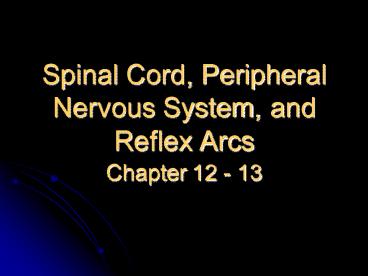Spinal Cord, Peripheral Nervous System, and Reflex Arcs - PowerPoint PPT Presentation
1 / 28
Title:
Spinal Cord, Peripheral Nervous System, and Reflex Arcs
Description:
2-way conduction pathway ; to and from brain. Major reflex center ... 'Some-Say-Marilyn-Monroe-But-My-Brother-Says-Bridget-Bardot-Mmmm-Mmmm' Spinal Nerves ... – PowerPoint PPT presentation
Number of Views:785
Avg rating:3.0/5.0
Title: Spinal Cord, Peripheral Nervous System, and Reflex Arcs
1
Spinal Cord, Peripheral Nervous System, and
Reflex Arcs
- Chapter 12 - 13
2
Characteristics
- 17 long ¾ thick
- 2-way conduction pathway to and from brain
- Major reflex center
- Extends from foramen magnum to L1
- Posterior to L1 is cauda equina
3
- Consists of gray matter (unmyelinated nerve
cells) and white matter
4
Gray Matter
- Looks like an H in cross section
- Contains
- posterior (dorsal) horns - association neurons
- Anterior (ventral) horns - cell bodies of somatic
motor neurons
5
- Amount of gray matter reflects amount of skeletal
muscle innervated at that level
Dorsal root
Ventral root
6
Nerve Roots
- Dorsal nerve root carries incoming messages
(sensory) - Ventral nerve root carries outgoing messages
(motor)
7
(No Transcript)
8
- Dorsal and ventral roots join to form 31 spinal
nerves - Poliomyelitis gray matter inflammation
viral disease which destroys the ventral horn of
the spinal cord virus is contracted through
contaminated water Salk and Sabin vaccines
prevent infection
9
White Matter
- Nerve tracts of myelinated and unmyelinated
fibers running in 3 directions - Up (ascending sensory)
- Down (descending motor)
- side to side
10
(No Transcript)
11
Pathology
- Paralysis loss of motor function
- Parathesias loss of sensation
- Paraplegia loss of lower limb function
- Quadraplegia loss of all limb function
12
- Hemiplegia brain disorder resulting in loss of
function on one side - Flaccid paralysis loss of muscle tone due to
damage of ventral horn or root - Spastic paralysis damage to brain neurons
muscles are stimulated by spinal nerves
13
Peripheral Nervous System
- Chapter 13
14
Cranial Nerves
- 12 pair only one of which extends down into the
body - Usually named for what they innervate
- Given Roman numerals in the order in which they
are located - O-O-O-T-T-A-F-V-G-V-A-H (structural)
15
- Oh-Oh-Oh-To-Touch-And-Feel-Very-Good-Velvet-AH!
- I Olfactory
- II Optic
- III Oculomotor
- IV Trochlear external eye muscle
16
- V Trigeminal sensory from eye, nose, cheek,
mouth, scalp - VI abducens external eye muscle
- VII facial skeletal muscles of face, tear
ducts, taste buds - VIII vestibulochochlear equilibrium, hearing
- IX Glossopharyngeal swallowing, gag reflex,
taste
17
- X Vagus heart, lungs, abdominal viscera,
taste, swallowing - XI Accessory larynx, pharynx, soft palate,
neck and head movement (shrugging) - XII Hypoglossal tongue movement
18
- Cranial nerves can be sensory, motor, or mixed
(both) - Some-Say-Marilyn-Monroe-But-My-Brother-Says-Bridg
et-Bardot-Mmmm-Mmmm
19
Spinal Nerves
- 31 pairs all are mixed nerves
- 8 cervical
- 12 thoracic
- 5 lumbar
- 1 coccygeal
20
- Spinal nerves leave the spinal cord, branch and
then converge again to form a complicated network
called a plexus - Allows muscles to receive its nerve supply from
more than one spinal nerve root
21
- Therefore a damaged nerve does not lead to total
motor or sensory loss in the limb region served
22
- There are several major plexi
- Cervical neck phrenic nerve (diaphragm) is
here - Brachial upper limbs radial nerve is the
largest
23
- Lumbar abdominal wall and thigh femoral nerve
is largest - Sacral thigh and lower leg sciatic nerve
(largest and longest nerve in body)
24
Reflexes
- Reflexes are rapid, predictable motor responses
to stimuli unlearned, involuntary,
unpremeditated 2 kinds - Somatic skeletal muscle
- Autonomic glands and involuntary muscle
25
- Reflex arc contains 5 elements
- Receptor (thermo, chemo, mechano, noci)
- Sensory neuron
- Integration center spinal cord
- Motor neuron
- Effector (muscle or gland)
26
(No Transcript)
27
- Types of reflexes
- Stretch (deep tendon) reflex coordinates muscle
control of paired muscles (bicep/tricep)
prevents over stretching, muscle tone - Withdrawl reflex initiated by actual or
perceived painful event prick finger, hot stove,
punch to abdomen, etc.
28
- Crossed extensor reflex complex helps to
maintain balance - Superficial reflex initiated by gentle touch
Babinski sign - Pupillary reflex - protective






























